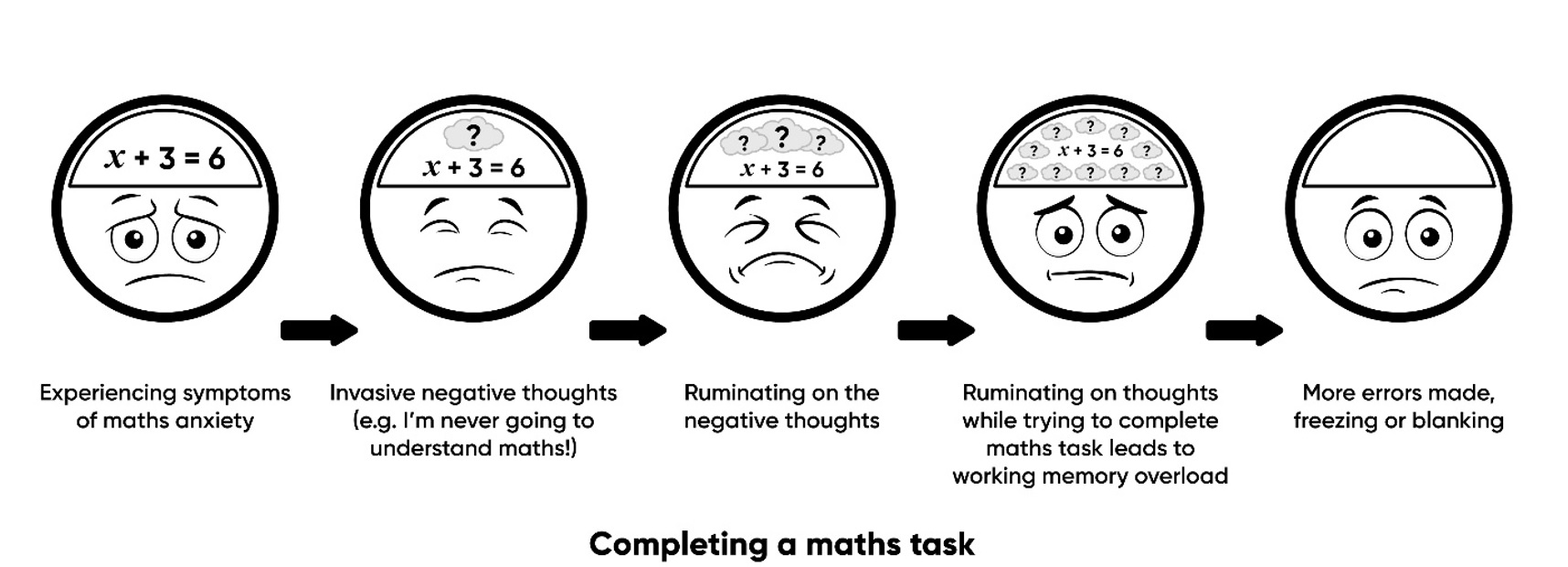The way that a student engages with mathematics influences the quality of their mathematical learning. One of the most significant factors that can shape this engagement in the classroom is mathematics anxiety – feelings of worry and nervousness when performing mathematical tasks.
A new monograph from the Victorian Department of Education and Training focuses on mathematics anxiety and research regarding the emotion and its impact on learning. The monograph is part of an eight-part resource produced by the Department and is designed to support principals, learning leaders and teachers to address mathematics anxiety from an evidence-based perspective in order to illustrate the research behind the approaches suggested. Some of the key discussion points within the monograph include:
- The impact of mathematics anxiety on teaching and learning.
- The symptoms, causes and companions of mathematics anxiety.
- Strategies that can identify and address mathematics anxiety in students and teachers.
The impact of mathematics anxiety on teaching and learning
Research has consistently demonstrated that individuals who are more anxious about mathematics tend to achieve at lower levels than those who are not (Eden et al., 2013; Ma, 1999), with studies suggesting that it is anxiety's impact on working memory that compromises mathematics potential when performing a mathematics task (Ashcraft & Kirk, 2001). Using diagrams such as Figure 1, the monograph details the mechanisms behind this negative impact on performance. It also discusses the potential for some teachers to experience mathematics anxiety and how this can shape classroom practice.
 Figure 1. The impact of mathematics anxiety on mathematics performance.
Figure 1. The impact of mathematics anxiety on mathematics performance.
The symptoms, causes and companions of mathematics anxiety
To help scaffold principals', learning leaders' and teachers' understanding of mathematics anxiety, the monograph presents a unique way of conceptualising the emotion by suggesting that anxiety has symptoms, causes and companions. The benefit of thinking of mathematics anxiety in this way, particularly in differentiating between its symptoms and causes, is because each of these different components of anxiety should be targeted by specific strategies (Buckley et al., 2016).
Strategies to identify and address mathematics anxiety in students and teachers
The monograph outlines a range of strategies and engagement activities that could be used to better understand and address students' and teachers' mathematics anxiety within the school environment. This includes activities intended to uncover negative feelings that younger children might have towards mathematics but are unable to express at their age. It also describes techniques appropriate for older students and adults. Individual and team-based activities for staff are also presented and are designed to help school leaders reflect on how mathematics anxiety might be experienced in the school community and the types of classroom practices that can facilitate its development.
The monograph also emphasises cultural and conceptual challenges associated with addressing mathematics anxiety – for instance, the pervasive negative culture and societal attitudes surrounding mathematics in the community. A pedagogical challenge for teachers seeking to reduce mathematics anxiety in the classroom can be understanding that sometimes successfully addressing mathematics anxiety does not require mathematics teaching or trying to make maths fun.
While helping to build mathematics confidence is a valuable strategy for some students it is not always effective, particularly for students who experience high levels of mathematics anxiety. Increasingly, research points to the significance of psychological strategies that directly reduce anxiety (Maloney, et al., 2013). The monograph describes how improving students' and teachers' ability to regulate or manage their anxiety through emotion regulation can: (1) reduce the negative impact of anxiety on performance, and (2) help to make students more receptive to mathematics teaching and therefore improve learning more generally in the classroom.
The mathematics anxiety monograph, written by ACER Senior Research Fellow Dr Sarah Buckley, is due to be published later this month. This monograph, and all the others in the series, will be available to access on the Victorian education department's website, via this link.
Stay tuned: ACER Senior Research Fellow Dave Tout will be sharing an overview of his monograph (Critical Connections between Numeracy and Mathematics) and discussing some of the content in an upcoming Teacher article.
References
Ashcraft, M. H., & Kirk, E. P. (2001). The relationships among working memory, math anxiety, and performance. Journal of Experimental Psychology: General, 130(2), 224-237.
Buckley, S., Reid, K., Goos, M., Lipp, O. V., & Thomson, S. (2016). Understanding and addressing mathematics anxiety using perspectives from education, psychology and neuroscience. Australian Journal of Education, 60(2), 157-170.
Eden, C., Heine, A., & Jacobs, A. M. (2013). Mathematics anxiety and its development in the course of formal schooling—a review. Psychology, 4(06), 27.
Ma, X. (1999). A meta-analysis of the relationship between anxiety toward mathematics and achievement in mathematics. Journal for Research in Mathematics Education, 30(5), 520-540.
Maloney, E. A., Schaeffer, M. W., & Beilock, S. L. (2013). Mathematics anxiety and stereotype threat: Shared mechanisms, negative consequences and promising interventions. Research in Mathematics Education, 15(2), 115-128.
As a teacher, what has been your own experience with mathematics anxiety? Have you experienced it yourself? Have you noticed it in colleagues or your students?
Think about your class, or a group of students you teach. Do you know how they feel about mathematics? Have you ever discussed this with them?



